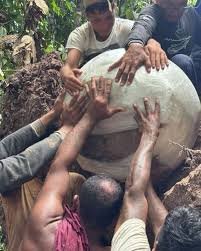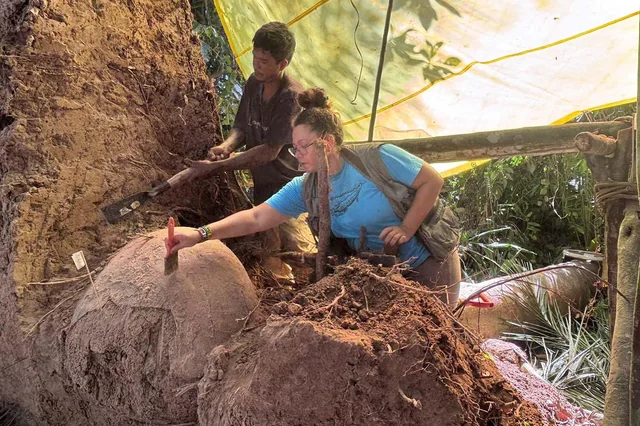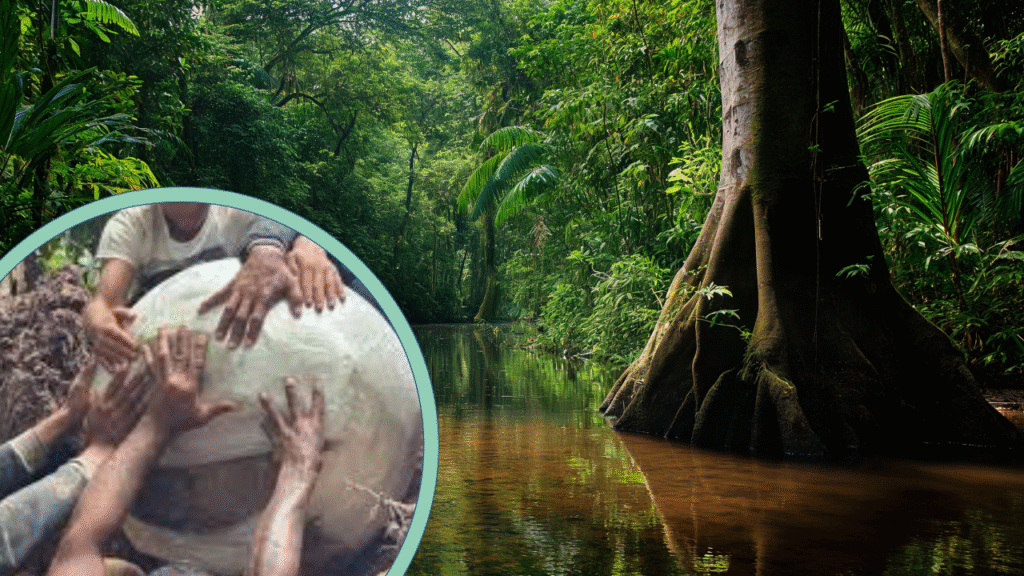A massive tree uprooted in Brazil’s Amazonas state has revealed more than just roots. Deep in the floodplains near Lago do Cochila, in the municipality of Fonte Boa, what appeared at first to be ordinary shapes turned out to be seven large ceramic funeral urns, brimming with surprises. As the scientific community begins to examine their contents, the urns promise to shift our understanding of Indigenous life in the pre-Columbian Amazon: not only how people buried their dead, but how daily life, ritual, ecology, and engineering intersected in a land shaped by water.
What Was Found: Urns, Bones, and a Mix of Life

When local fishermen noticed pottery fragments exposed among the roots of the fallen tree, they alerted the Mamirauá Institute for Sustainable Development. Upon excavation, archaeologists discovered seven ceramic spheres of unusually large size — the largest nearly three feet in diameter and weighing about 770 pounds.
Inside these vessels were human skeletal remains alongside animal bones including turtle shells and fish remains. The assemblage is striking: a funeral urn that does not contain only human remains, but is shared with fauna, raising questions about ritual, symbolic meaning, and relationship between food, life, death, and memory.
Geórgea Layla Holanda, one of the lead archaeologists, described the urns as likely having been sealed originally by organic material, now long decomposed. The urns were buried about 40 centimeters (≈16 inches) beneath the surface, possibly beneath old house floors.
Distinctive Pottery Traditions and Unanswered Questions
These urns do not appear to match any known ceramic traditions in the region. They differ in style, shape, and materials from the Amazon Polychrome Tradition, Borda Incisa, or earlier Pocó-Açutuba ceramics. The pots are rounder, heavier, more voluminous, often without lids, and made of a rare greenish clay with traces of red slip or engobe decoration.
Anne Rapp Py-Daniel of the Federal University of West Pará, who was not part of the excavation team, noted that the absence of ceramic lids and the fuller rounded shapes are unlike what has been documented in Middle Solimões or other sectors of the Amazon.
Carbon dating and precise chronological placement are still pending. Preliminary estimates suggest that these urns could be centuries to perhaps up to 2,000 years old, but researchers emphasize that more testing — including sediment, bone, charcoal, and isotopic analyses — is required to tighten the dates.
Landscape, Engineering, and Community Context

The site of the discovery is significant: artificial islands in the floodplain region, part of a network of raised earth mounds engineered by past Indigenous groups. These served to elevate living spaces above regularly inundated terrain. The fallen tree’s uprooted root ball had lifted urns nearly three meters off the ground in some cases, entangled deeply among roots. A scaffolding and careful extraction protocol were necessary to rescue the fragile artifacts.
According to archaeologists, such earthworks and raised settlements are not isolated: aerial surveys and ground studies have increasingly documented engineered landscapes across the Solimões and Negro rivers, with plazas, roads, mounds, and artificial soils. The urns’ placement — possibly beneath domestic floors — suggests funerary practices were integrated into daily life rather than confined to separate cemeteries.
Moreover, the excavations were remarkable for their deep involvement of local communities. Local fishermen first spotted the urns; residents helped build platforms, transport the heavy urns, and make logistical plans. Archaeologists have emphasized that this collaboration has ensured careful, respectful handling of both artifacts and site.
Ritual Implications and New Directions in Amazon Archaeology

The mixed contents of the urns — human bones along with fish and turtle remains — pose provocative questions: were the animal remains offerings, part of feasting rituals, or practical components (e.g., food placed deliberately)? Do they reflect beliefs about the afterlife, of nourishment continuing beyond death, or ancestral communion? As researcher Karen Marinho (not part of the field team) commented, the find is “unprecedented” for this part of the Amazon.
The discovery also points to how much remains unknown about pre-Colonial Amazonian societies, especially in floodplain zones where water and decay often hamper preservation. The urns’ distinct features might reflect a previously undocumented cultural group or local variant. Scientists hope isotopic, residue, and DNA analyses will reveal diet, mobility, age, and possibly relationships to modern Indigenous populations.
A Window into the Amazon’s Hidden Past
The sudden exposure of these ancient urns — brought to light by a fallen tree — is more than an archaeological curiosity. It is a window into ritual, engineering, and Indigenous presence in a landscape often misrepresented as untamed wilderness rather than a shaped, inhabited, and spiritually rich home. As the full scientific study continues, these urns have the potential both to enrich what we know of Amazonian prehistory and to challenge assumptions about ceramic traditions, funerary rites, and how communities lived and died in harmony with the rhythms of river and flood.
What we learn from these ceramic spheres may prove as much about the living heritage of local communities — their knowledge, their stories — as about bones and clay. And in that sense, this discovery reminds us that sometimes, from the roots of a fallen tree, rises a past that has long been waiting to be heard.

Hi, I’m Andrew, and I come from India. Experienced content specialist with a passion for writing. My forte includes health and wellness, Travel, Animals, and Nature. A nature nomad, I am obsessed with mountains and love high-altitude trekking. I have been on several Himalayan treks in India including the Everest Base Camp in Nepal, a profound experience.




